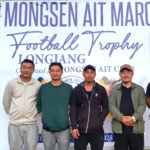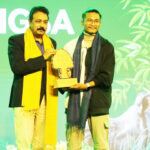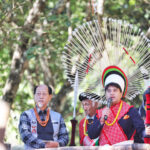It is interesting to note that indigenous Naga Wrestling will be exhibited in the Ao Naga area at Saringyim Village, Mokokchung, perhaps for the first time, in conjunction with the premier Moatsü Festival. The event is supported by the Nagaland Wrestling Association, marking a very welcome development.
Naga wrestling is a folk wrestling style and traditional sport of the Nagas, closely related to Ssireum, the traditional national sport of Korea. The objective of the sport is to bring any part of the opponent’s body above the knee to the ground.
Naga wrestling is played by the Tenyi–mi ethnic group of the Nagas—Angami, Chakhesang, and Zeliangrong of Nagaland, and Mao, Maram, and Poumai of Manipur. Wrestling is not new to the Ao Nagas; our forefathers used to wrestle frequently, even settling disputes through wrestling bouts. Somehow, along the way, we lost it, but now we’re finally reviving it. It’s been a long time coming. Leaving aside our traditional wrestling for now, we should encourage our men to play the now-popular Naga wrestling, as the benefits are innumerable.
Each wrestler wears a colored cloth tied around the waist. Holding the opponent’s waist-binder with both hands, the wrestler must attempt to topple the other onto the ground. Kene is one of the oldest traditional games of the Nagas. Though this style of wrestling has been practiced in the region for several centuries, the modern version of the sport was developed only in the mid-20th century.
It is said that the construction of the highway between Kohima and Imphal in the 1930s and 1940s brought together many Tenyimi villagers to participate in road construction to earn some cash, as it was a burden to pay house tax to the British regime when cash was scarce at that time. During lunch breaks, wrestling matches would be held among the workers. Each respective village leader chooses its best wrestlers to participate in the matches.
Interestingly, the first organized wrestling meet was initiated by the Federal Government of Nagaland in 1965, as per sources. It was later reinforced with the formation of the Naga Wrestling Board in 1969, under which the first Naga Wrestling Championship was held on May 20, 1971.
Traditionally, the match takes place within a circular ring filled with mounded dirt. Modern matches are held in a wrestling ring. Contestants wear a towel or a belt around their waist, which is used for takedowns.
At the start of the match, both contestants hold each other in a grappling position, with each wrestler grabbing the other’s belt. The fight begins with the referee’s whistle, who works within the ring to judge and control the conduct of the wrestlers, rule on their ability to wrestle safely, count knocked-down wrestlers, and rule on fouls.
A single match is contested in a best-of-three fights format, in which the wrestler to win two fights first wins the match. There are no weight classifications.



